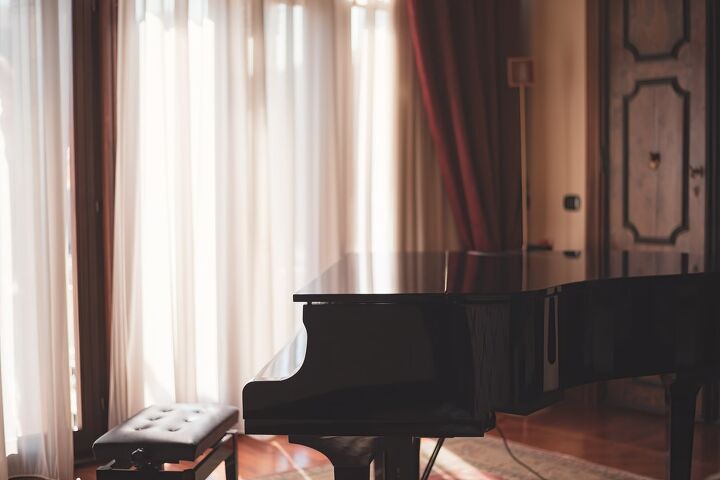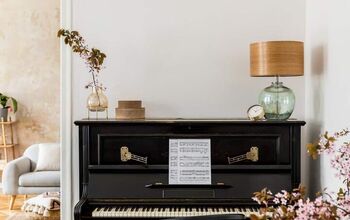Grand Piano Sizes (with Drawings)

There is no other musical instrument in the world that compares to the grand piano. Its elegance, sound quality, and unparalleled aesthetic make it a dream instrument for musicians and music lovers alike. With the many types of grand pianos available today, you won’t be hard-pressed to find the perfect one for you.
There are several different types of grand pianos ranging from 53 inches to 114 inches long. Despite the varying lengths, these pianos are generally 58-60 inches wide and about 3-4 feet tall. In addition, the accompanying piano bench usually measures 30 inches wide and 19 inches tall.
Grand piano sizes are essential to consider, especially when you have limited room space. Size is not the only essential factor, however. You also have to take into account sound quality, as well as the actual look and finish of the instrument.
Types of Grand Pianos and Their Sizes
There are five major classifications of grand pianos. From the smallest to the biggest, these would be the petite, baby, parlor or living room, semi-concert or ballroom, and concert. Aside from the difference in sizes, you will find each one comes with its own set of pros and cons.
Petite Grand Piano
The petite grand piano is the smallest of the grand pianos. The two things it shares with its bigger counterparts are its width and the number of keys. But, aside from these similarities, the petite has its own distinct characteristics.
The petite grand piano is about 53-58 inches long and stands about 40 inches tall. Being relatively small in stature, the petite does not deliver the same sound quality as its larger counterparts. You can’t expect the miniature soundboard in a petite to produce the rich, ponderous sounds of a traditional grand piano.
Despite being the smallest, petite grand pianos are still large instruments requiring more than one person to move. Petites can easily weigh 400 pounds, and some even tip the scales at 500 pounds.
Baby Grand Piano
The baby grand piano looks as adorable as it sounds, but don’t let its looks deceive you. Despite its cuteness, this baby is just as worthy an instrument as its larger, bulkier brothers. You can expect a well-made baby grand to deliver exceptional sounds under the fingers of a talented, experienced piano player.
A typical baby grand piano stands 36 inches tall and is 65-75 inches in length. With its 88 keys, it is about 58-60 inches wide and weighs anywhere from 500-600 pounds. The hospital industry often favors baby grands, and you can find them sitting prettily in many posh hotel lobbies.
Parlor or Living Room Grand Piano
Aptly dubbed the living room or parlor grand, you may find this piano in the sitting room of affluent homes. The parlor grand also serves as a piano for live performances in smaller music venues. In addition, some rehearsal spaces are fortunate to have a parlor grand as the instrument for beginner piano players.
The parlor grand piano stands at 40-44 inches tall and is about 69-79 inches in length. The standard width of 58-60 inches also applies to the parlor grand. This elegant instrument weighs 750 pounds, at least 150 pounds more than the baby grand.
Semi-Concert or Ballroom Grand Piano
The ballroom grand piano is ubiquitous in, yes, ballrooms, as well as music halls and venues for the performing arts. This type of grand piano may not be the grandest of them all, but it no doubt produces quality music.
The ballroom grand piano is approximately 78-89 inches in length, 58-60 inches wide, and weighs about 900 pounds. It is also utilized in recording studios because of its impressive tone minus the massive proportions of a concert grand.
Concert Grand
The concert grand piano is the be-all and end-all of grand pianos. With its impressive size and unmistakable grandeur, the concert grand piano is truly a sight to behold. Concert grand pianos serve as the instrument of choice in the most famous amphitheaters and concert halls across the globe.
This magnificent work of art measures anywhere from 90-108 inches long, with the longest one at an impressive 114 inches. Most of them come with the standard 88 keys, but you can find a few of them with 108 keys.
Concert grand pianos grace the stages of storied theaters around the world, with only the best pianists tickling their ivories. A brand new concert piano costs at least $120,000-$200,000, an investment only a few venues can afford.
How to Take Care of Your Piano
A piano is not simply a piece of furniture sitting at a corner of your house. It is an investment for some, an inheritance for others, and a source of joy for most. Taking care of your piano and performing general maintenance on it will help your piano live a rich, long life.
Placement of the Piano
One way to ensure your piano stays in tip-top shape is knowing where to place it in a room. Not merely furniture, a grand piano is an investment piece handed down from one generation to another. But thinking of your piano as an expensive piece of furniture helps in this process.
When positioning your piano, place it in one part of the room that does not get too much foot traffic. This will ensure that your piano does not get bumped or scraped from the daily occurrences of normal life. Furthermore, do not put your piano under hanging plants or under a ceiling fan.
Another place to avoid positioning your piano is in front of a window, a doorway, or any type of air vent. These magnificent instruments are sensitive to changes in humidity and temperature and do not do well under erratic wind conditions. Instead, find a spot in the room where the temperature stays at a relatively stable level.
Cleaning the Piano
Nominate one member of the family to take on piano dusting duties. Use a clean, dry cloth or chamois and run gently along the piano surface and keys. Always close the piano to protect the keys when someone isn’t playing it.
Do not attempt to clean the inside of your grand piano. The soundboard, strings, and metal components are best left in the care of a professional piano technician. You may schedule a piano cleaning, along with tuning, at least twice a year.
Ventilating your piano by opening the lid is also advisable to discourage humidity from settling on the inside. However, if the room is particularly dusty or the air quality is not ideal, keep the piano lid constantly closed. Also, keep the surface free of flower vases, and do not set down wine glasses or coffee cups on it.
Tuning the Piano
Every piano owner must have the contact number of a professional, reliable piano tuner stored on their phone. Upon arrival at your house, your piano needs to settle in and have a tuning in the next few days. A second tuning service should occur six months later, after which one tuning every year after should suffice.
Professional piano tuners have the skills, knowledge, and tools to help keep your piano sounding beautiful for many long years. To look for a certified piano tuner, ask local music schools or piano teachers in the area for their recommendations.
Moving a Piano
One look at a grand piano and you will know that moving it all by yourself would prove quite impossible. Sometimes, a piano may have to be moved from room to room. You will need a piano trolley with well-tired casters.
If not in possession of a piano trolley, the best move to make is to call in professional piano movers. While a petite baby grand may seem relatively easier to handle, this little beast still weighs at least 400 pounds. Therefore, moving a piano is best left to professionals.
Related Questions
Which type of grand piano should I get?
There are many factors to consider when choosing a grand piano. You should ask yourself the following questions before deciding on the type of piano for you.
- How big of a space do I have for the piano?
- What kind of sound quality am I looking for?
- Who will be playing it?
Along with these important questions, you may also want to consider the aesthetics of the piano. The color and finish of the wood should complement the room the instrument will be in. Ideally, first, choose the piano you desire, then decorate the rest of the room accordingly.
How much is a grand piano?Grand pianos are considerable investment pieces, whether you buy one brand new or second-hand. A basic model would cost about $7,000, and a concert grand can leave you $200,000 poorer. Some piano brands are more reliable and established than others, so do your research first.
If working with a limited budget, consider getting a second-hand grand piano from a reputable seller. Used pianos range from $3,000-$40,000, depending on the type of grand you want. Employ the services of a piano technician to inspect the inner workings of a used instrument you wish to purchase.
Summing It Up
Having a musical instrument in the home is always a good idea. Choosing a grand piano to grace your home is both a delight and a responsibility. Take loving care of your grand piano, and it will give you music and joy for many years to come.

Stacy Randall is a wife, mother, and freelance writer from NOLA that has always had a love for DIY projects, home organization, and making spaces beautiful. Together with her husband, she has been spending the last several years lovingly renovating her grandparent's former home, making it their own and learning a lot about life along the way.
More by Stacy Randall































